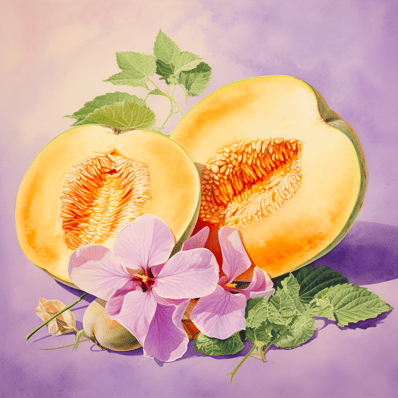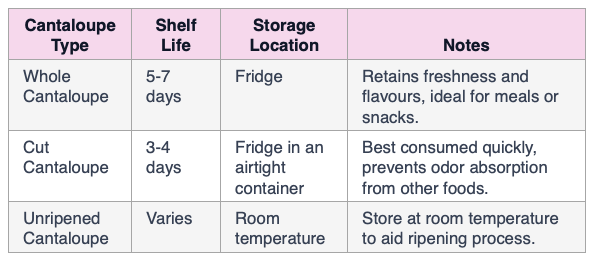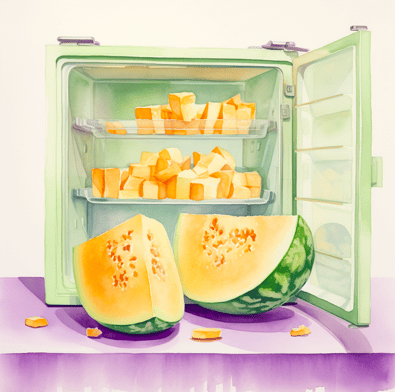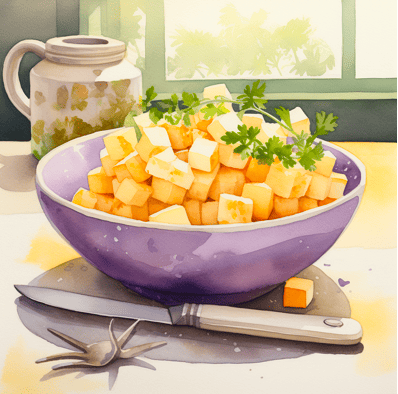
Don’t want to read the whole post?
A whole cantaloupe can last about 5-7 days in the fridge, while cut cantaloupe should be eaten within 3-4 days. Store cut pieces in an airtight container for freshness. Look for a sweet aroma and soft texture for ripe cantaloupes.
ABOUT ME
Be beauty. Be plant-based!
As a former Registered Nurse and avid plant-muncher, I’m in love with how simple plant-based foods make it easy to be beautiful.

You’ll also love:
Apricots vs Nectarines: Comparing The Sweet And Succulent
In our journey towards a healthier, more radiant self, understanding the subtleties of our diet is key. Today, we’re diving into a sweet and juicy favourite: the cantaloupe. This delicious fruit is not just a treat to our taste buds but a vibrant addition to our plant-based lifestyle. However, an important question arises: “How long does cantaloupe last in the fridge?” Knowing this not only ensures we’re eating fruit at its best but also helps us make the most of what we buy from grocery stores.
A Cantaloupe’s Shelf Life
When it comes to theshelf life of cantaloupe, a few factors come into play.
A whole cantaloupe can comfortably sit in your fridge for about 5-7 days. During this time, it retains its freshness and flavours, making it a perfect addition to your meals or as a stand-alone snack.

But the story changes a bit when we talk about cut cantaloupe. Once sliced, the shelf life of cut cantaloupe shortens, and it’s best to consume these cantaloupe pieces within 3-4 days.
Remember, the goal is to enjoy our cantaloupe at its best quality, and proper storage is key to achieving that.

You’ll also love:
Plum Magic: Fruity Benefits for Your Skin
Storage Tips
The key to prolonging the freshness of cantaloupe, especially once it’s cut, lies in its storage. Cut cantaloupe demands a bit more care.
For those who have an unripe cantaloupe, storing it at room temperature is the way to go. This encourages the ripening process, allowing the fruit to reach its peak sweetness and texture. Once it’s ripe, move it to the fridge if you’re not ready to eat it right away.
For uncut cantaloupe or whole melons, storing them at room temperature is often the best choice. This is particularly true for cantaloupes that aren’t fully ripe. Keeping them in a dry place away from direct sunlight, such as on your kitchen counter, allows the natural ripening process to continue. This is the easiest way to ensure you get to enjoy a perfectly ripe fruit.
As for cut cantaloupes, to maximise its shelf life, its best to store it in the fridge in an airtight container. This not only keeps the cantaloupe fresh but also safeguards it from absorbing any unwanted flavours from other foods in the fridge.

However, once the cantaloupe reaches its peak ripeness, or for cut cantaloupe, refrigeration becomes crucial. Storing a ripe or cut-up cantaloupe in the fridge, particularly in a plastic container, helps to maintain its freshness, taste, and nutritional value. It also slows down the processes that can make the cantaloupe go bad. Once the protective skin is removed, the fruit becomes more susceptible to bacteria and spoilage.
In summary, while uncut and unripe cantaloupes are best kept at room temperature, ripe or cut cantaloupes should always be refrigerated to extend their shelf life and preserve their quality.
Identifying Spoiled Cantaloupe
Knowing how to tell if cantaloupe has gone bad is crucial to avoid wasting food and to ensure your safety.
Bad cantaloupes often give themselves away through their appearance and smell. A soft spot on the rind or a change in texture could be a sign of spoilage.
Moreover, an off odour – something that doesn’t smell like the sweet aroma we associate with fresh cantaloupe – is a clear warning sign. These signs of spoilage can also include visible mould growth on the fruit’s surface. It’s important to discard these cantaloupes to prevent the risk of consuming harmful bacteria.
Remember, when in doubt, it’s better to err on the side of caution and throw it out.
Choosing the Perfect Cantaloupe
Selecting the best cantaloupe at your local grocery store can be a delightful part of your shopping experience.

Look for cantaloupes that feel heavy for their size and have a uniform shape. The sweet aroma of a good cantaloupe is a telltale sign of its ripeness and readiness to be enjoyed. The skin should exhibit a netted pattern and the colour underneath this netting should be more creamy than green, indicating a ripe and fresh cantaloupe.
Remember, a perfect cantaloupe is not just about its appearance, but also its fragrance and feel.
Ripeness and Overripeness: What to Look For
Understanding the signs of overripe cantaloupes is as important as knowing how to pick them.
An overripe cantaloupe might have overly soft spots or an exaggeratedly sweet smell. These ripe fruits can still be eaten, but they might lack the firm texture and nuanced flavours of a perfectly ripe one.

On the other hand, a cantaloupe that’s too hard and lacks any scent might need more time to ripen, ideally at room temperature. This natural process allows the sugars to develop fully, enhancing the taste and texture of the fruit.
Keep an eye on your cantaloupe as it sits in your fruit bowl; when it’s just right, it’s a refreshing treat, especially on a hot day.
Avoiding Food Poisoning
While cantaloupe is delicious and healthy, it’s essential to handle it properly to avoid any risk of food poisoning.
Always wash the outer surface of the cantaloupe thoroughly before cutting into it. This helps to remove any harmful bacteria that might be present on the rind, which can be transferred to the fruit’s flesh when slicing.
Once cut, store the cantaloupe in the refrigerator and consume within a few days to ensure it stays fresh. If you’re storing cut cantaloupe, wrapping it in plastic wrap or placing it in an airtight container can also help keep it safe and fresh.
By taking these simple steps, you can enjoy your cantaloupe without any worries and make the most out of this delicious fruit.
Creative Ways to Use Cantaloupe
Cantaloupe isn’t just for eating as is; it can be a versatile ingredient in your kitchen. On a hot day, enjoying cut wedges of chilled cantaloupe can be incredibly refreshing.

But there’s more to this fruit than just slicing and eating. Consider adding cantaloupe to your morning smoothies for a sweet, fruity twist. Its juicy flavour pairs well with other fruits and adds a touch of summer to any drink.
For a more creative use, try incorporating cantaloupe into a Cantaloupe Salad. It brings a unique sweetness that complements leafy greens and other salad ingredients. Cantaloupe can also be a delightful addition to a fruit platter, giving a colourful and tasty option in your fruit bowl.
How long does cantaloupe last in the fridge?
In conclusion, understanding how long does cantaloupe last in the fridge is crucial for those who enjoy this delicious fruit. Proper storage, whether at room temperature for ripening or in the fridge inside an airtight container, plays a significant role in maintaining the sweet aroma and freshness of cantaloupe. By selecting the best cantaloupe from your grocery store and storing it correctly, you can savour its delightful taste to the fullest, contributing to a satisfying and healthy plant-based diet. This knowledge not only enhances your culinary experiences but also aids in reducing food waste, making each cantaloupe you buy a step towards a more sustainable lifestyle. Remember, the right practices in selecting and storing cantaloupe can transform your eating experience, making every bite of this refreshing fruit a joyous occasion.
FAQ: All About Cantaloupe
How Do You Know if a Cantaloupe is Good?
To determine if a cantaloupe is good, check for a slight give when you press the blossom end (opposite the stem). A good cantaloupe will also have a sweet and slightly musky aroma. The rind beneath the netted pattern should be creamy or golden, not green.
What Colour is a Ripe Cantaloupe?
A ripe cantaloupe typically has a beige, creamy, or golden-yellow colour under its netted skin. If the colour is greenish, it may not be fully ripe.
How Do You Tell if a Cantaloupe is Fresh and Ripe?
A fresh and ripe cantaloupe will feel heavy for its size and have a firm but slightly yielding feel when pressed gently. It should have a fragrant, sweet smell at the blossom end. The netting on the skin should be raised and well-defined, and the colour should be more yellowish than green.
Can You Eat Overripe Cantaloupe?
Yes, you can eat overripe cantaloupe, but it might not have the best texture and taste. Overripe cantaloupe can be softer and mushier. If there are signs of spoilage like mould or an unpleasant odour, it’s best to discard it. Overripe cantaloupe can still be used in smoothies or purees.
Will Cantaloupe Ripen in the Fridge?
Cantaloupe does not significantly ripen once refrigerated. It’s best to allow cantaloupes to ripen at room temperature. Once they reach the desired ripeness, refrigerate them to maintain their sweetness and texture. Refrigerating an unripe cantaloupe can halt the ripening process.